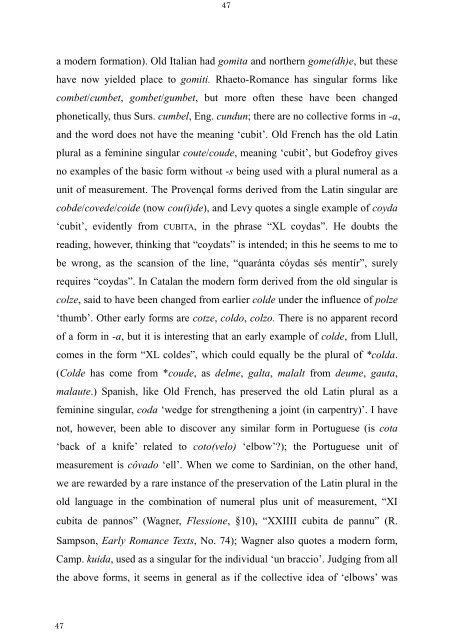The Latin Neuter Plurals in Romance - Page ON
The Latin Neuter Plurals in Romance - Page ON
The Latin Neuter Plurals in Romance - Page ON
You also want an ePaper? Increase the reach of your titles
YUMPU automatically turns print PDFs into web optimized ePapers that Google loves.
47<br />
47<br />
a modern formation). Old Italian had gomita and northern gome(dh)e, but these<br />
have now yielded place to gomiti. Rhaeto-<strong>Romance</strong> has s<strong>in</strong>gular forms like<br />
combet/cumbet, gombet/gumbet, but more often these have been changed<br />
phonetically, thus Surs. cumbel, Eng. cundun; there are no collective forms <strong>in</strong> -a,<br />
and the word does not have the mean<strong>in</strong>g ‘cubit’. Old French has the old <strong>Lat<strong>in</strong></strong><br />
plural as a fem<strong>in</strong><strong>in</strong>e s<strong>in</strong>gular coute/coude, mean<strong>in</strong>g ‘cubit’, but Godefroy gives<br />
no examples of the basic form without -s be<strong>in</strong>g used with a plural numeral as a<br />
unit of measurement. <strong>The</strong> Provençal forms derived from the <strong>Lat<strong>in</strong></strong> s<strong>in</strong>gular are<br />
cobde/covede/coide (now cou(i)de), and Levy quotes a s<strong>in</strong>gle example of coyda<br />
‘cubit’, evidently from CUBITA, <strong>in</strong> the phrase “XL coydas”. He doubts the<br />
read<strong>in</strong>g, however, th<strong>in</strong>k<strong>in</strong>g that “coydats” is <strong>in</strong>tended; <strong>in</strong> this he seems to me to<br />
be wrong, as the scansion of the l<strong>in</strong>e, “quaránta cóydas sés mentír”, surely<br />
requires “coydas”. In Catalan the modern form derived from the old s<strong>in</strong>gular is<br />
colze, said to have been changed from earlier colde under the <strong>in</strong>fluence of polze<br />
‘thumb’. Other early forms are cotze, coldo, colzo. <strong>The</strong>re is no apparent record<br />
of a form <strong>in</strong> -a, but it is <strong>in</strong>terest<strong>in</strong>g that an early example of colde, from Llull,<br />
comes <strong>in</strong> the form “XL coldes”, which could equally be the plural of *colda.<br />
(Colde has come from *coude, as delme, galta, malalt from deume, gauta,<br />
malaute.) Spanish, like Old French, has preserved the old <strong>Lat<strong>in</strong></strong> plural as a<br />
fem<strong>in</strong><strong>in</strong>e s<strong>in</strong>gular, coda ‘wedge for strengthen<strong>in</strong>g a jo<strong>in</strong>t (<strong>in</strong> carpentry)’. I have<br />
not, however, been able to discover any similar form <strong>in</strong> Portuguese (is cota<br />
‘back of a knife’ related to coto(velo) ‘elbow’?); the Portuguese unit of<br />
measurement is côvado ‘ell’. When we come to Sard<strong>in</strong>ian, on the other hand,<br />
we are rewarded by a rare <strong>in</strong>stance of the preservation of the <strong>Lat<strong>in</strong></strong> plural <strong>in</strong> the<br />
old language <strong>in</strong> the comb<strong>in</strong>ation of numeral plus unit of measurement, “XI<br />
cubita de pannos” (Wagner, Flessione, §10), “XXIIII cubita de pannu” (R.<br />
Sampson, Early <strong>Romance</strong> Texts, No. 74); Wagner also quotes a modern form,<br />
Camp. kuida, used as a s<strong>in</strong>gular for the <strong>in</strong>dividual ‘un braccio’. Judg<strong>in</strong>g from all<br />
the above forms, it seems <strong>in</strong> general as if the collective idea of ‘elbows’ was









